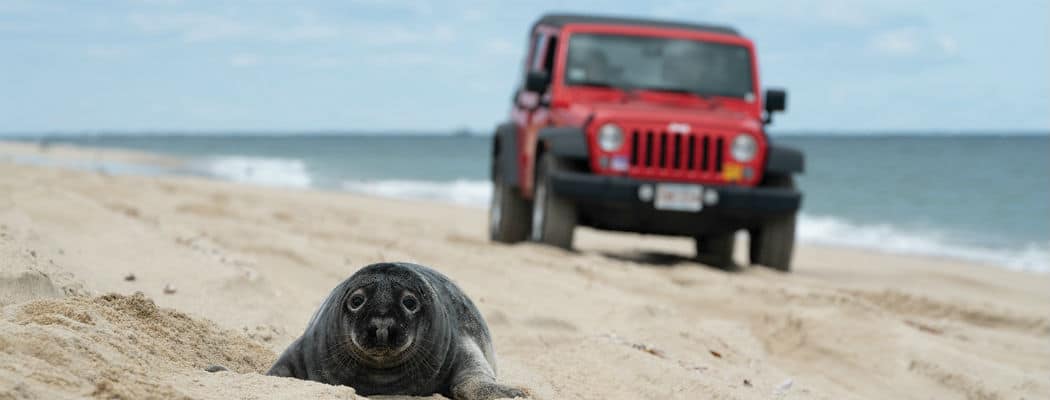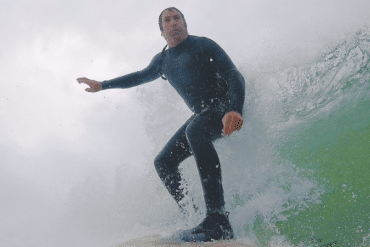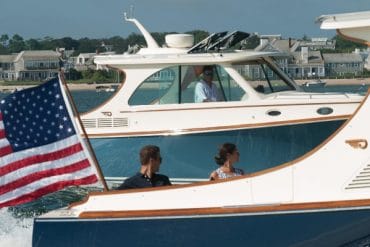The contentious debate over one of Nantucket’s most iconic landmarks.
Every summer for decades, Peter Krogh would run his fire engine red 1957 Willys pickup over to the Wauwinet gatehouse and hiss the tires down to 12psi. Fishing rods jiggling in the back, he’d shimmy the truck over five miles of sand to the trail’s end. Just off the northern-most point of the Coskata-Coatue peninsula, colliding currents from the Atlantic Ocean and Nantucket Sound converge on Great Point, creating ideal fishing conditions. For generations, this scenic spit of sand with Great Point lighthouse as a backdrop was a surfcasting utopia that drew anglers from up and down the Eastern Seaboard. But roughly ten years ago, all that began to change.
 Vehicle access to the peninsula has been partially restricted since 1975, with varying bird nesting grounds, access points and sand trails cordoned off for several weeks every year. In 2009, the very tip of Great Point became completely off limits to even those on foot, restricting access to this prime fishing spot and signaling the beginning of a drastic shift for fishermen like Peter Krogh and his fishing partners. In their eyes, the protection of piping plover nesting grounds at the point, which has reduced human presence, has also opened the floodgates to the onslaught of gray seals, rendering Great Point not so great these days.
Vehicle access to the peninsula has been partially restricted since 1975, with varying bird nesting grounds, access points and sand trails cordoned off for several weeks every year. In 2009, the very tip of Great Point became completely off limits to even those on foot, restricting access to this prime fishing spot and signaling the beginning of a drastic shift for fishermen like Peter Krogh and his fishing partners. In their eyes, the protection of piping plover nesting grounds at the point, which has reduced human presence, has also opened the floodgates to the onslaught of gray seals, rendering Great Point not so great these days.
Today, Krogh doesn’t buy a permit to bring the Willys out to Great Point. The row of stickers on his truck’s bumper ends with the one issued in 2016. “For me, this is a highly personal, visceral thing,” he says of the circumstances that have limited once-unfettered public access to Great Point and caused some, like him, to abandon it entirely. “I just don’t think this should go on.” As Krogh and his friends Peter Howell and Guy Snowden fight to “reclaim a treasured feature of Nantucket” as they put it, they raise the question: Between humans, birds and seals – who is most entitled to Great Point?
The 1,100 acres of the Coskata-Coatue Wildlife Refuge — consisting of Coskata, Coatue, a narrow sand bar called the Galls, and most of Great Point — is overseen by a myriad of state, national and local groups. Twenty-one acres at the tip of the peninsula are jointly managed by The Trustees of Reservations — a Massachusetts nonprofit focused on conservation and public access — and the US Fisheries and Wildlife Service, a US Department of the Interior agency.
 A 438-page Fisheries and Wildlife conservation plan released in 2013 says Great Point is “recognized internationally” for its premier fishing. The report also acknowledges anglers’ frustration with the off-limits area at the tip of the point meant to protect visitors from seals and seals from visitors. It’s been there almost year-round since 2008, although it was intended to expand and contract as seal migratory patterns change. The report also notes that the number of oversand permits sold by The Trustees has been declining every year since 2007 – probably, the report says, because of all the closures.
A 438-page Fisheries and Wildlife conservation plan released in 2013 says Great Point is “recognized internationally” for its premier fishing. The report also acknowledges anglers’ frustration with the off-limits area at the tip of the point meant to protect visitors from seals and seals from visitors. It’s been there almost year-round since 2008, although it was intended to expand and contract as seal migratory patterns change. The report also notes that the number of oversand permits sold by The Trustees has been declining every year since 2007 – probably, the report says, because of all the closures.
On a recent midsummer day, Diane Lang drives a white Ford pick- up with a green logo along a stretch of open beach towards Great Point. Wearing the Trustees’ khaki uniform, Lang is stewardship manager for Coskata-Coatue Wildlife Refuge, which includes the twenty-one acres known as Great Point. She steers the truck over dips and swells, adjusting her sunglasses and ignoring the greenhead flies and mosquitoes swarming the windshield.
Jeeps and SUVs line the water’s edge from north of the spot known as the Haul-Over to marker three, where a thin cord on metal stakes stretches across the sand. The cord is there because of the birds. The Trustees and Fisheries and Wildlife are de facto guardians of three kinds of endangered or threatened terns and a sparrow-sized shorebird called the piping plover.
While the birds nest from spring into late July, vehicles are kept away because they stress the birds and can accidentally destroy their nests. Lang points to a wooden frame where a gull perches. The sign once declared the perimeter of the Nantucket National Wildlife Refuge, a wildlife sanctuary for migratory birds. Another nesting habitat is at the tip of Great Point, where every summer for decades beach fishermen spent hour upon hour surfcasting on the Sound.
“Ninety-nine percent of the people who come out [to Great Point] want to do the right thing. They love it here for all of the right reasons,” she says. “And then you have that one percent who feel like they have the right to gripe because they can’t do what they did growing up.” Lang says most visitors understand the need to balance conservation and recreation. “People who come here have a matter-of-fact attitude,” she says. “They say, ‘What’s open today? Two and a half miles of beach? I can walk that, perfect!’” She gazes from the van at the waves lapping the shore. Gulls dip and glide. Terns dance over the packed sand. “Perspective is everything,” she says. “And humans have a very short-term perspective.”
Just down the beach from Lang’s truck, Edward and Patricia Chase are lounging on beach chairs under a rainbow-striped umbrella. A fishing rod sticks upright in a holder near a red Jeep Wrangler. There are drinks in a cooler and snacks. Ed’s been coming to Great Point for almost fifty years, he says, since he was a boy. Patty remembers fishing out at the rip. Now they surfcast. “You don’t catch as much dinner as you used to,” she says. “The fishing is still good, but the catching isn’t as great as it was.” Ed says he spotted a bunch of striped bass that morning just offshore, but the seals chased them off.
 Since 2008, Great Point has become a prime seal breeding ground. Fishermen like Peter Krogh believe that limiting
the human presence
on the point to protect
the birds has invited
an influx of these un-
wanted guests. Starting in the late 19th
century, thousands of seals were killed every year in Maine and Massachusetts bounty hunts — $1 to $5 for a nose, tail or entire skin. By the 1960s, seals were practically extinct, prompting Congress to pass the Marine Mammal Protection Act in 1972. Over the past forty-six years, seals have re-bounded. There’s no official count, but a 2017 study estimated 50,000 or more gray seals live in southeastern Massachusetts waters. On any given day, gray seals can be spotted on and around Great Point.
Since 2008, Great Point has become a prime seal breeding ground. Fishermen like Peter Krogh believe that limiting
the human presence
on the point to protect
the birds has invited
an influx of these un-
wanted guests. Starting in the late 19th
century, thousands of seals were killed every year in Maine and Massachusetts bounty hunts — $1 to $5 for a nose, tail or entire skin. By the 1960s, seals were practically extinct, prompting Congress to pass the Marine Mammal Protection Act in 1972. Over the past forty-six years, seals have re-bounded. There’s no official count, but a 2017 study estimated 50,000 or more gray seals live in southeastern Massachusetts waters. On any given day, gray seals can be spotted on and around Great Point.
In response to this influx of seals, Peter Krogh and fellow fishermen Peter Howell and Guy Snowden founded the Seal Abatement Coalition in 2011. They rattle off grievances: Fisheries and Wildlife cordons off the area once used primarily by anglers; the seals are turning the beach into a breeding ground; they defecate; their excrement is unsightly and smelly, and can harbor parasites that infect cod; seals attract Great White sharks.
To members of the Seal Abatement Coalition, it’s a question about a common sense approach to managing an ecosystem. Why, Howell asks, is there no provision for removing a no-longer- threatened species from the Marine Mammal Protection Act? Such has been the case with the Steller sea lion, the gray whale and other marine mammals that have been delisted from the Endangered Species Act. Why is there so little funding for seal research and management? Why can no one define an “optimum sustainable population” of gray seals? What are the long-term effects of an uncontrolled seal population?
Krogh and Howell are heartened that the National Oceanic and Atmospheric Administration is working on a list of “safe and legal deterrent methods” for seals that approach fishing gear. That’s what they really want at this point: a way to stop the marauding seals from stealing their catch. In the meantime, the NOAA website advises recreational fishermen to remove their gear from the water if a seal approaches.
 Krogh and Howell are aware that their idyllic fishing era at Great Point might be a throwback, like Krogh’s Willys truck. Some might view them as “a bunch of old disaffected recreational fishermen,” as Howell puts it. But to others, these old fishermen might just represent the last Nantucketers who remember when Great Point was, indeed, the greatest.
Krogh and Howell are aware that their idyllic fishing era at Great Point might be a throwback, like Krogh’s Willys truck. Some might view them as “a bunch of old disaffected recreational fishermen,” as Howell puts it. But to others, these old fishermen might just represent the last Nantucketers who remember when Great Point was, indeed, the greatest.







